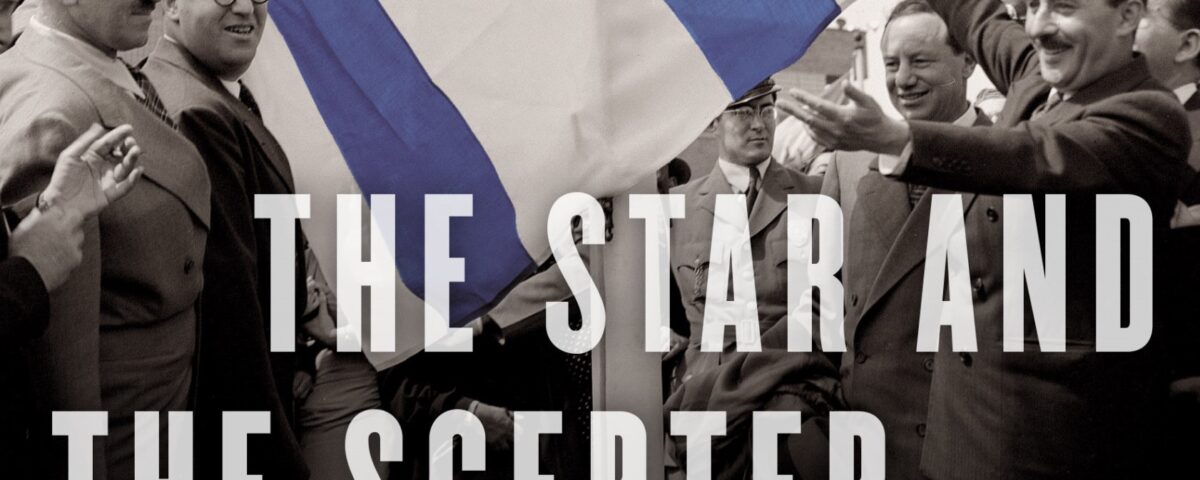REVIEW: The Star and the Scepter

 Emmanuel Navon, The Star and the Scepter: A Diplomatic History of Israel (Jewish Publication Society, 2020), 536 pages.
Emmanuel Navon, The Star and the Scepter: A Diplomatic History of Israel (Jewish Publication Society, 2020), 536 pages.
Diplomacy, in the words attributed to the late David Frost, is “the art of letting somebody else have your way.” Although cynical, this definition highlights the complexity countries face with their shared relationships, navigating the delicate balance between their self-interests and their allies. In many ways, diplomacy is like a global mixer dance, whereby countries swap partners and intel as they prance around the international stage. The way Emmanuel Navon maps the choreography of this field’s multi-layered density is what makes his latest book, The Star and the Scepter: A Diplomatic History of Israel, a groundbreaking work.
In The Star and the Scepter, Navon, a political scientist specializing in Israel’s international relations, pursues the ambitious goal of compiling a complete and thorough record of the Jewish State’s diplomatic history. Unlike many other works, he does not begin with the founding of the nation or the emergence of political Zionism; instead, he starts with God’s selection of Abraham as the founding father of His great nation. Navon divides his work into four parts: the Hebrew Bible, Jewish antiquity and modernity, the founding of the State of Israel, and contemporary world affairs. The first two sections are presented in an almost strictly chronological manner, while the last two diverge into parallel timelines.
[Read excerpts of The Star and the Scepter here.]
Underlying his historical account, Navon works with an interesting theory that, from its origin, the Jewish People grappled to maintain their grasp on both “the star and the scepter,” a reference to the prophet Bilaam’s words that “A star rises from Jacob, a scepter comes forth from Israel” (Numbers 24:17). Simply put, Navon explains the “star” to signify Jewish faith and the “scepter” to mean Jewish power. While diplomacy is always a compromise between “ideals and realpolitik,” in the case of Israel, it is especially apropos, as the Bible requires harmony between the two to assure the Jewish People’s success (xix). While novel in bridging contemporary ideas with traditional faith, this theory is generally absent from Navon’s voice throughout the book. Nevertheless, after reflecting on the Jewish People’s story as laid out in The Star and the Scepter, one appreciates how Navon’s framework works in developing a national narrative.
The greatest strengths of The Star and the Scepter lie in its scope and approach of telling the Jewish story, with its breadth of information, and its accessibility to all readers.
Israel’s Declaration of Independence is colored with the language of a nation much older than one born in the twentieth century. It states, “After being forcibly exiled from their land, the people kept faith with it throughout their Dispersion and never ceased to pray and hope for their return to it and for the restoration in it of their political freedom. Impelled by this historic and traditional attachment, Jews strove in every successive generation to re-establish themselves in their ancient homeland.” The declaration makes constant reference to the biblical prophets and the Jewish People’s longing to return to the Promised Land. The Jewish People’s narrative cannot, in the view of Israel’s founders, be separated from its biblical and historic story, yet, more often than not, historians struggle to write and teach about Israel in that way. That is why Navon’s narrative approach for this book is significant. From the inception of nationhood with Abraham and the realization of that vision with Moses, to the Temples’ destructions and the new realities of Diaspora, Navon extends the thread of his book throughout the length of Jewish history.
This approach also provides essential context for the mindset of the Jewish People throughout that history and for the State of Israel today. Israeli national security expert Charles D. Freilich suggests that to discuss Israel today is not to speak of a country founded in 1948 but a nation reborn after thousands of years. This is essential for understanding the contentious battles within Israel surrounding its existential fears of destruction and its commitment to its Jewish identity. In that vein, Navon succeeds in developing a chronicle that both naturally and effectively captures the Jewish story.
That said, in this area, one disappointment was the limited exploration of Navon’s thesis as it plays out in the Hebrew Bible. Only 40 pages (of over 400 pages of text) are devoted to the tension between star and scepter as it plays out in Tanakh. To my mind, the book would have benefited from further exploration about the interactions between Moses and Pharaoh, for instance, and drawing on other scholarship about diplomacy in ancient times.

Emmanuel Navon
That aside, The Star and The Scepter is an almost encyclopedic reference guide to all things concerning Israeli diplomacy, as Navon takes the readers into spheres too often ignored in Israeli history. While one expects any historical book on Israel to include the classic topics — the Dreyfus Affair, Zionism, the Palestinian-Israeli Conflict, and Israel’s “special relationship” with the United States — there is often not much discussed outside that periphery. For Navon, those subjects are appropriately covered in this book, but the array of other topics he covers, some of which I learned about for the first time in these pages, add an important range to the information of his work. This specifically applies to some of his third and all of the fourth parts of the book.
For example, most people do not consider the Cold War between the United States and the former Soviet Union when thinking about Israel’s early years, nor would they have much knowledge about those world powers’ Mideast foreign policy in the mid-1900s. Navon, however, succinctly captures the role that geopolitics, realpolitik, and identity had in forming the Israel we see today. In the final section of the book, Navon delves deeper into these topics. He covers Israel’s diplomatic relations with countless countries, spanning those in Europe to those in Asia and Africa. Even for many interested in Israeli foreign policy, basic knowledge of Israel’s relationship with, say, Asian countries like China, India, Thailand, and Pakistan are virtually unknown and undiscussed. We tend to associate the success of Israel’s foreign policy solely based on its relations to the United States or other larger, Western powers. In doing so, however, we ignore other aspects of Israeli diplomacy that also color its state of affairs, such as the success of Israeli high-tech with many Japanese companies or the complexities of Israel selling weaponry to oppressive countries (330-31). Of course, one cannot expect the average Zionist or Jew to be well-versed in the less overtly significant relationships in Israel’s history, but even on an academic front, the complexity is too frequently disregarded.
One rather large gap in The Star and the Scepter, however, is in discussing the diplomatic footprints around the Holocaust. Even though the Holocaust is mentioned in different parts of the book, since there is not a focused chapter on it, it can feel to the reader as though Navon casually hopped over those years without any explanation. The enduring impact of the Holocaust is evident in Israeli foreign policy today, as seen by Israel’s outrage over Poland’s recent legislation that will restrict World War II-era restitution claims. I think it was a difficult choice to make, as including a chapter on the Holocaust risks diluting the intricacies surrounding it. Even so, an explicit acknowledgment of Navon’s thought process may have been advisable.
Navon’s audience for this book is as broad as his coverage of Israeli history. Whether Jewish or non-Jewish, academic or amateur, The Star and the Scepter is accessible to all. One of the problems encountered with historical books in general, but especially with those focusing on niche subjects such as diplomacy, is readability. Navon evades this problem. While scholarly historical tomes cannot read like riveting novels, one can sometimes dread the expected verbose, overdrawn, and high-brow language used by too many academics. In The Star and the Scepter Navon writes with clarity and precision, making it an enjoyable and edifying read.
Additionally, one can begin reading The Star and The Scepter, for the most part, at any juncture. While there is surely background information and context needed to understand Israel’s emergence on the world stage, for example, the reader can jump around that part of the book with relative ease, especially since the chapters follow parallel timelines. As such, The Star and the Scepter is a trusted companion for any individual seeking an in-depth understanding of Israel, Israel’s relations with other countries or region, or a quick reference to a historical event.
Since The Star and the Scepter’s publication last year, Israel has achieved new diplomatic milestones. From the signing of the Abraham Accords, its faltering image in the public eye after the Israel-Hamas war in May, and its recent admission to the African Union as an observer state, Israel is already in a transformed international arena than the one Navon describes. This highlights the need for a book like The Star and the Scepter, because to truly understand anything about the Israel of today, we need to understand the Israel of yesterday and the Israel of antiquity. As Israel continues to try and effectively wield both its star and its scepter, Navon’s The Star and the Scepter proves itself to be an ever-growing staple for anyone invested in the future of the State of Israel.
Sruli Fruchter is a senior at Yeshiva University studying International and Global Affairs. He is currently the Editor in Chief of The YU Commentator, and he was previously an International Relations Intern and Ronald S. Lauder Fellow at the World Jewish Congress.

1 Comment
Beautifully written! Sruli will do great things!